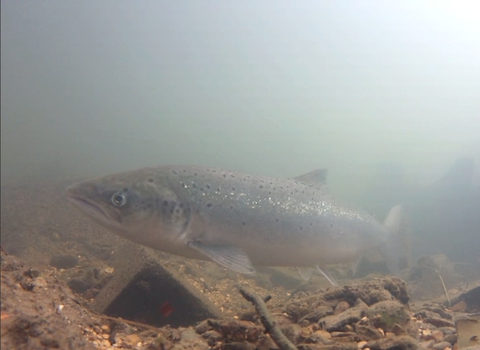
Atlantic Salmon leaping ©Rob Jordan/2020VISION

Atlantic Salmon ©Jack Perks
Atlantic salmon
The Atlantic salmon spends most of its life at sea, but makes an epic journey back to the river or stream in which it hatched to spawn. Look out for it in freshwater rivers in the north and west.
Enw gwyddonol
Salmo salarPryd i'w gweld
January to DecemberGwybodaeth am rywogaethau
Ystadegau
Length: 1.2-1.5mWeight: up to 40kg
Average Lifespan: up to 13 years
Priority Species under the UK Post-2010 Biodiversity Framework.
Cynefinoedd
Ynghylch
A large fish, the Atlantic salmon is found in the cleanest rivers, mostly in the north and west. It spends most of its life at sea, but returns to spawn in the same stretch of river or stream in which it hatched. Travelling upstream from November to February, Atlantic salmon can be spotted jumping over weirs and waterfalls to get to the gravelly headwaters where they breed. Once they have reached their breeding grounds, the females dig depressions, known as 'redds', in the gravel; the eggs and sperm are released simultaneously into the water. The juveniles will stay in freshwater for up to six years, after which they migrate back to the sea - morphological changes allowing them to survive in salt water. Atlantic salmon are predators, feeding on invertebrates and small fish.Sut i'w hadnabod
Adult Atlantic salmon are much larger than trout; they are silvery with a few dark spots on the back and may have a pinkish flush to the belly. Mature males may develop a hooked lower jaw, or 'kype', in the breeding season.Dosbarthiad
Found in rivers in Wales, Scotland and North and South West England.Roeddech chi yn gwybod?
Known as the 'King of the Fish', the Atlantic salmon is able to clear seemingly insurmountable obstacles during its journey to spawn: from waterfalls to weirs, Atlantic salmon have been known to leap vertical obstacles more than 3 metres tall. However, these obstacles take energy to pass, and man-made barriers to migration are considered one of the most pressing threats to our salmon populations.It is unclear how Atlantic salmon navigate to the breeding grounds of their own hatching, but it is thought that smell is important when they are in fresh water and that the Earth's magnetic field plays a part when they are at sea.
